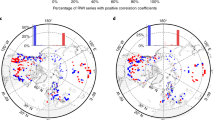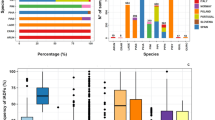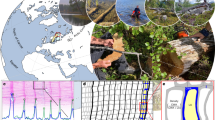Abstract
Tree-ring chronologies that represent annual changes in the density of wood formed during the late summer can provide a proxy for local summertime air temperature1. Here we undertake an examination of large-regional-scale wood-density/air-temperature relationships using measurements from hundreds of sites at high latitudes in the Northern Hemisphere. When averaged over large areas of northern America and Eurasia, tree-ring density series display a strong coherence with summer temperature measurements averaged over the same areas, demonstrating the ability of this proxy to portray mean temperature changes over sub-continents and even the whole Northern Hemisphere. During the second half of the twentieth century, the decadal-scale trends in wood density and summer temperatures have increasingly diverged as wood density has progressively fallen. The cause of this increasing insensitivity of wood density to temperature changes is not known, but if it is not taken into account in dendroclimatic reconstructions, past temperatures could be overestimated. Moreover, the recent reduction in the response of trees to air-temperature changes would mean that estimates of future atmospheric CO2 concentrations, based on carbon-cycle models that are uniformly sensitive to high-latitude warming, could be too low.
This is a preview of subscription content, access via your institution
Access options
Subscribe to this journal
Receive 51 print issues and online access
$199.00 per year
only $3.90 per issue
Buy this article
- Purchase on Springer Link
- Instant access to full article PDF
Prices may be subject to local taxes which are calculated during checkout


Similar content being viewed by others
References
Schweingruber, F. H. Tree Rings. Basics and Applications of Dendrochronology(Kluwer, Dordrecht, (1988)).
Schweingruber, F. H. & Briffa, K. R. in Climate Variations and Forcing Mechanisms of the Last 2000 Years(eds Jones, P. D., Bradley, R. S. & Jouzel, J.) 43–66 (Springer, Berlin, (1996)).
Bräker, O. Der Alterstrend bei Jahrringdichten und Jahrringbreiten von Nadelhölzern und sein Ausgleich. Mitt. forstl. Bundesvers Anst Wien 142, 75–102 (1981).
Briffa, K. R., Jones, P. D., Schweingruber, F. H., Karlén, W. & Shiyatov, S. G. in Climate Variations and Forcing Mechanisms of the Last 2000 Years(eds Jones, P. D., Bradley, R. S. & Jouzel, J.) 9–41 (Springer, Berlin, (1996)).
Cook, E. R., Briffa, K. R., Meko, D. M., Graybill, D. A. & Funkhouser, G. The ‘segment-length curse’ in long tree-ring chronology development for palaeoclimatic studies. Holocene 5, 229–237 (1995).
Schweingruber, F. H., Briffa, K. R. & Nogler, P. Atree-ring densitometric transect from Alaska to Labrador. Int. J. Biometeorol. 37, 151–169 (1993).
D'Arrigo, R. D., Jacoby, G. C. & Free, R. M. Tree-ring width and maximum latewood density at the North American tree line: parameters of climate change. Can. J. Forest Res. 22, 1290–1296 (1992).
Graybill, D. A. & Shiyatov, S. G. in Climate Since A. D. 1500(eds Bradley, R. S. & Jones, P. D.) 393–414 (Routledge, London, (1992)).
Graumlich, L. J. A1000-year record of temperature and precipitation in the Sierra Nevada. Quat. Res. 39, 249–255 (1993).
Cook, E. R., Briffa, K. R. & Jones, P. D. Spatial regression methods in dendroclimatology: a review and comparison of two techniques. Int. J. Climatol. 14, 379–402 (1994).
Jones, P. D. & Briffa, K. R. Global surface air temperature variations during the twentieth century: Part 1, spatial, temporal and seasonal details. Holocene 2, 165–179 (1992).
Jacoby, G. C. & D'Arrigo, R. D. Reconstructed Northern Hemisphere annual temperature since 1671 based on high-latitude tree-ring data from North America. Clim. Change 14, 39–49 ((1989)).
Jacoby, G. C. & D'Arrigo, R. D. Tree ring width and density evidence of climatic and potential forest change in Alaska. Glob. Biogeochem. Cycles 9, 227–234 (1995).
Briffa, K. R., Jones, P. D. & Hulme, M. Summer moisture variability across Europe, 1892–1991: an analysis based on the Palmer Drought Severity Index. Int. J. Climatol. 14, 475–506 (1994).
Nicholls, N. et al. in Climate Change 1995(eds Houghton, J. T. et al.) 133–192 (Cambridge Univ. Press, (1996)).
Groisman, P. Y., Karl, T. R. & Knight, R. W. Observed impact of snow cover on the heat balance and the rise of continental spring temperatures. Science 263, 198–200 (1994).
Hogg, P. H. & Hurdle, P. A. The aspen parkland in western Canada: a dry-climate analogue for the future boreal forest? Wat. Air Soil Pollut. 82, 391–400 (1995).
Fleming, R. A. & Volney, J. A. Effects of climate change on insect defoliator population processes in Canada's boreal forest: some plausible scenarios. Wat. Air Soil Pollut. 82, 445–454 (1995).
DeLuisi, J. J. et al. Northern and middle-latitude ozone profile features and trends observed by SBUV and Umkehr, 1979–1990. J. Geophys. Res. 99, 18901–18908 (1994).
Sullivan, J. H. in Stratospheric Ozone Depletion/UV-B Radiation in the Biosphere(eds Biggs, R. H. & Joyner, M. E. B.) 67–76 (Springer, Berlin, (1994)).
Tevini, M. in Stratospheric Ozone Depletion/UV-B Radiation in the Biosphere(eds Biggs, R. H. & Joyner, M. E. B.) 37–56 (Springer, Berlin, (1994)).
Bryson, R. A. & Goodman, B. M. Volcanic activity and climatic changes. Science 207, 1041–1044 (1980).
Asaturov, M. L. et al. Volcanoes, Stratospheric Aerosols and Earth's Climate(Gidrometeoizdat, Leningrad, (1986)) [In Russian].
Bradley, R. S. & Jones, P. D. in Climate Since A.D. 1500(eds Bradley, R. S. & Jones, P. D.) 606–622 (Routledge, London, (1992)).
Melillo, J. M., Prentice, I. C., Farquhar, G. D., Schulz, E.-D. & Sala, O. E. in Climate Change 1995(eds Houghton, J. T. et al.) 444–481 (Cambridge Univ. Press, (1996)).
Hättenschwiler, S., Schweingruber, F. H. & Körner, C. Tree ring responses to elevated CO2and increased N deposition in Picea Abies. Plant Cell Environ. 19, 1369–1378 (1996).
Wigley, T. M. L. Balancing the carbon budget. Implications for projections of future carbon dioxide concentration changes. Tellus B 45, 409–425 (1993).
Craig, S. G. & Holmén, K. J. Uncertainties in future CO2projections. Glob. Biogeochem. Cycles 9, 139–152 (1995).
Ciais, P., Tans, P. P., Trolier, M., White, J. W. C. & Francey, R. J. Alarge northern hemisphere terrestrial CO2sink indicated by the 13C/12C ratio of atmospheric CO2. Science 269, 1098–1102 (1995).
Osborn, T. J., Briffa, K. R. & Jones, P. D. Adjusting variance for sample size in tree-ring chronologies and other regional-mean timeseries. Dendrochronologia(in the press).
Acknowledgements
We thank P. Nogler, T. Forster, B. Feiertag and E. Schär, WSLFNP, for densitometry and chronology construction, and G. Jacoby and C. Körner for comments on the manuscript. This work was supported by the Swiss Federal Institute of Forest, Snow and Landscape Research, the Swiss National Science Foundation, the European Community Environment and Climate Programme and the UK NERC.
Author information
Authors and Affiliations
Corresponding author
Rights and permissions
About this article
Cite this article
Briffa, K., Schweingruber, F., Jones, P. et al. Reduced sensitivity of recent tree-growth to temperature at high northern latitudes. Nature 391, 678–682 (1998). https://doi.org/10.1038/35596
Received:
Accepted:
Issue Date:
DOI: https://doi.org/10.1038/35596
This article is cited by
-
Stability assessment of tree ring growth of Pinus armandii Franch in response to climate change based on slope directions at the Lubanling in the Funiu Mountains, China
Journal of Forestry Research (2024)
-
Spatial and temporal patterns of the sensitivity of radial growth response by Picea schrenkiana to regional climate change in the Tianshan Mountains
Journal of Forestry Research (2023)
-
Wood structure explained by complex spatial source-sink interactions
Nature Communications (2022)
-
Drought timing and severity affect radial growth of Picea crassifolia at different elevations in the western Qilian Mountains
International Journal of Biometeorology (2022)
-
Responses of radial growth of Picea crassifolia to climate change over three periods at different elevations in the Qilian Mountains, northwest China
Trees (2022)
Comments
By submitting a comment you agree to abide by our Terms and Community Guidelines. If you find something abusive or that does not comply with our terms or guidelines please flag it as inappropriate.



